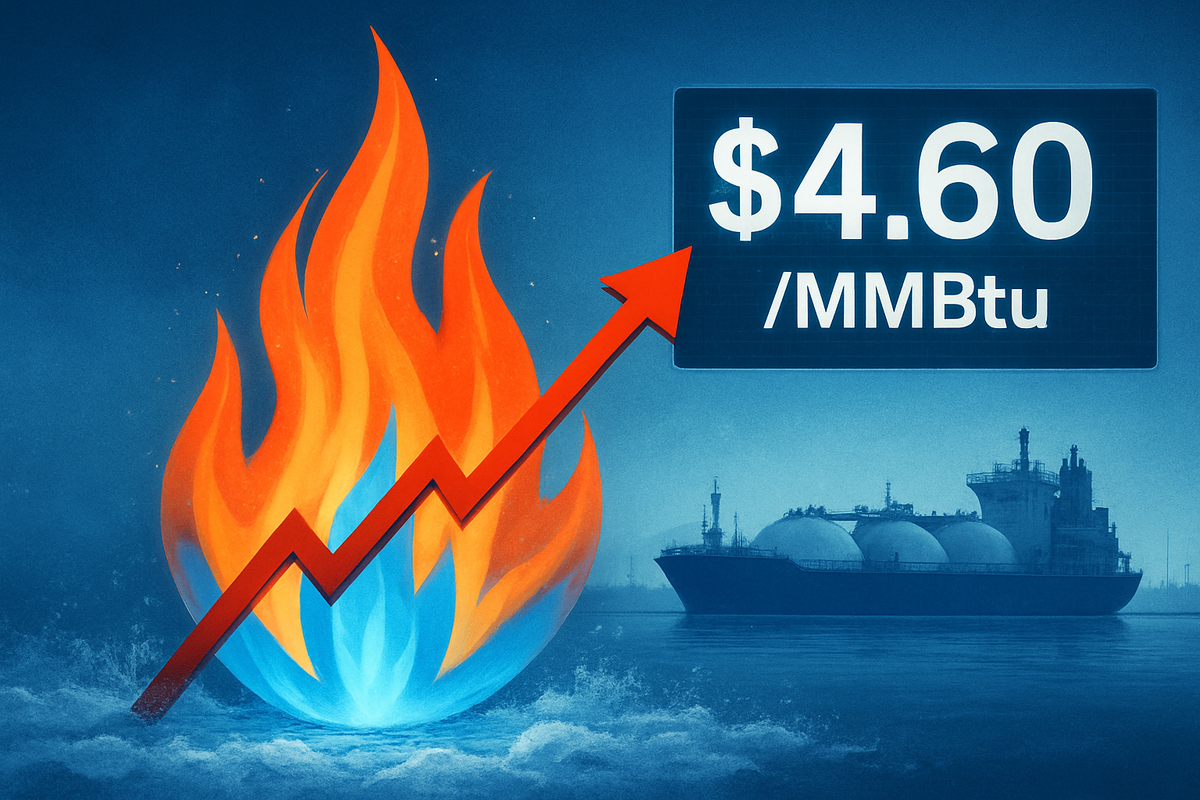
The natural gas market has ignited, with benchmark Henry Hub futures contracts surging to an impressive $4.60 per MMBtu as of November 13, 2025. This significant price jump, marking a substantial increase from previous levels, is sending ripples across the energy sector and beyond. The rally is a potent cocktail of anticipations: forecasts of a colder-than-average winter, persistently strong global demand for Liquefied Natural Gas (LNG), and a notable surge in Henry Hub prices, which have seen a rapid climb in recent weeks.
This sudden escalation in natural gas prices carries immediate and far-reaching implications. Consumers are bracing for higher heating and electricity bills, while energy-intensive industries face increased operational costs. The market is demonstrating its acute sensitivity to supply-demand fundamentals, weather patterns, and geopolitical developments, setting the stage for a dynamic and potentially volatile winter heating season.
The Perfect Storm: Unpacking the Natural Gas Price Surge
The ascent of natural gas prices to near $4.60/MMBtu is the result of several converging factors that have created a tight supply-demand balance. The market has been keenly watching these developments, leading to a rapid repricing of natural gas futures, particularly for December 2025 delivery on the NYMEX.
The upward momentum began building in late October and early November 2025. A "sudden shift to colder weather forecasts" across the central and eastern United States triggered a significant increase in buying activity around October 20, breaking a two-week losing streak and pushing the November NYMEX natural gas contract higher. This early cold snap continued into November, intensifying heating demand. Simultaneously, robust LNG exports sustained their upward trajectory, with an energy analyst reporting on November 10, 2025, that weekend Henry Hub prices had lifted to a seven-month high of $3.76 per MMBtu. On the same day, LNG exports reached a record high of 18.1 billion cubic feet per day (Bcf/d). The December natural gas contract, after a brief pullback, "skyrocketed to test $4.509" on the morning of November 10, reflecting heightened market tension. By November 12, 2025, U.S. natural gas prices officially surged to an eight-month high, directly attributed to the early cold snap and strong LNG exports. The International Energy Agency (IEA) also revised its overall gas demand outlook upwards, noting that global LNG capacity is expected to rise by about 50% by the end of the decade. As of November 13, 2025, the market continues to react to these strong bullish signals, pushing prices towards the $4.60/MMBtu threshold.
The primary drivers behind this surge are multifaceted. Firstly, winter cold forecasts are a major catalyst. The National Weather Service's Climate Prediction Center projects a La Niña pattern for Winter 2025–26, historically bringing colder conditions across the North and West, and increasing the potential for mid-winter storms. The early cold snap in November has accelerated this impact, causing immediate spikes in heating demand. Secondly, strong LNG demand is a critical structural driver. New LNG export terminals in the U.S. Gulf Coast are either coming online or ramping up, significantly increasing U.S. export capacity. Global LNG demand is forecast to rise substantially, driven by economic growth in Asia and emissions reduction efforts. This sustained export pull keeps the domestic market tight. Lastly, the Henry Hub surge and volatility underscore the market's sensitivity. While a direct "58% Henry Hub surge to $4.60" isn't explicitly detailed as a single event, the rapid climb from $3.76/MMBtu to testing $4.509/MMBtu within days indicates an extremely sharp and substantial percentage increase, reflecting rapid repricing and short-covering by traders.
Key players and stakeholders in this dynamic market include natural gas producers like EQT Corporation (NYSE: EQT) and Comstock Resources (NYSE: CRK), whose production decisions significantly influence supply. LNG exporters such as Cheniere Energy Inc. (NYSE: LNG) and Venture Global LNG are central to robust export demand. Utilities and consumers represent the demand side, directly impacted by price fluctuations. Finally, traders and financial institutions actively participate in the NYMEX futures market, contributing to price discovery and liquidity. Initial market reactions have been characterized by rapid repricing and strong bullish sentiment, though some caution about potential pullbacks if winter weather proves milder than expected.
Winners and Losers: Corporate Impact of the Price Spike
The significant jump in natural gas prices to $4.60 per MMBtu is creating a clear divide among public companies, generating substantial opportunities for some while imposing considerable challenges on others. The impact largely hinges on a company's position within the natural gas value chain.
Natural gas producers (upstream companies) are poised to be significant winners. Companies like EQT Corporation (NYSE: EQT), the largest natural gas producer in the U.S., Antero Resources (NYSE: AR), Comstock Resources (NYSE: CRK), and Range Resources (NYSE: RRC), primarily operating in prolific basins like the Appalachian and Permian, will see higher revenues and improved profit margins for their extracted gas. While some production may be hedged, unhedged volumes will directly benefit from the elevated spot and futures prices. Even integrated oil and gas supermajors like Exxon Mobil (NYSE: XOM) and Chevron (NYSE: CVX), with substantial natural gas production, will see a positive contribution to their upstream segments.
LNG exporters are also major beneficiaries. Companies such as Cheniere Energy Inc. (NYSE: LNG), the leading U.S. LNG exporter, and Venture Global LNG are experiencing robust demand from global markets. Higher international LNG prices and sustained demand translate into increased export volumes and margins, especially as their procurement costs are often tied to U.S. benchmarks. These companies effectively bridge the gap between abundant U.S. supply and global energy needs.
Midstream companies, which own and operate pipelines, processing plants, and storage facilities, tend to benefit from increased natural gas activity. Companies like Kinder Morgan Inc. (NYSE: KMI), The Williams Companies (NYSE: WMB), and ONEOK (NYSE: OKE) typically earn fee-based revenues based on the volume of gas transported, processed, and stored. Higher production and demand lead to greater throughput, ensuring stable and often increasing revenues, largely insulated from direct commodity price volatility.
Conversely, industrial consumers that rely heavily on natural gas as a feedstock or primary energy source will face increased costs, impacting their profitability. Sectors such as chemical companies (e.g., LyondellBasell Industries (NYSE: LYB), Westlake Corp. (NYSE: WLK)), fertilizer producers, glass manufacturers, and steel producers will see their production costs rise significantly. If these costs cannot be fully passed on to consumers in competitive markets, profit margins will be squeezed.
Utilities, particularly those with a high reliance on natural gas for power generation or those in regulated markets, are likely to face headwinds. Electricity utilities with significant natural gas power generation, such as Duke Energy Corporation (NYSE: DUK), Exelon Corporation (NASDAQ: EXC), and Xcel Energy (NASDAQ: XEL), will incur higher fuel costs. While regulated utilities can eventually pass these costs to consumers, there can be a time lag, compressing short-term margins. Natural gas distribution utilities, like Atmos Energy Corporation (NYSE: ATO) and CenterPoint Energy, Inc. (NYSE: CNP), may also face pressure from customer affordability and regulatory scrutiny if prices remain persistently high.
Beyond the Immediate: Wider Significance and Market Trends
The natural gas price jump to $4.60 per MMBtu on November 13, 2025, is more than a fleeting market event; it reflects profound shifts in industry trends, geopolitical dynamics, and energy policy. This price point, notably higher than the $2-$3/MMBtu averages of 2024, signifies a tightening market with extensive ripple effects.
This surge fits into broader industry trends characterized by strong demand across sectors, with U.S. natural gas consumption reaching record levels in 2024-2025 due to extreme cold and heightened industrial activity. LNG export growth remains a dominant factor, with U.S. exports projected to grow by 18% in 2025, reaching 15.2 Bcf/d. The commissioning of new terminals and sustained global demand, particularly from Europe and Asia, keeps the domestic market tight. Geopolitical volatility, including conflicts impacting key shipping routes, continues to inject a risk premium into LNG and piped gas trade. Despite record U.S. natural gas production, supply constraints and low storage levels in some regions suggest a delicate balance, exacerbated by capital discipline among producers limiting rapid output scaling. Furthermore, weather sensitivity and the increasing energy demands of artificial intelligence (AI) data centers are adding new layers of complexity to demand forecasting.
The ripple effects are substantial. In the electricity market, higher gas prices directly translate to increased generation costs, leading to higher wholesale and retail electricity prices, especially in gas-reliant regions. This can also lead to public backlash against utilities and potentially a temporary resurgence in coal use, though aging coal plants limit this trend. The industrial sector faces significantly higher production costs, potentially forcing some manufacturers to reduce or suspend operations. While residential and commercial consumers will see increased natural gas prices, the impact is generally less severe due to gradual rate adjustments and regulatory processes. For the renewable energy sector, sustained high natural gas prices can accelerate investments in solar, wind, and energy storage, as countries seek to reduce reliance on volatile fossil fuels.
From a regulatory and policy perspective, the $4.60/MMBtu price surge could prompt governments to explore market stabilization measures, such as strategic reserves or incentives for domestic production. Environmental regulations, particularly concerning methane leakage from LNG, could intensify, impacting decarbonization goals. Higher natural gas prices also reinforce the economic rationale for accelerating the energy transition, driving policies that support renewable energy. However, policy risks like tariffs or infrastructure delays could constrain supply growth. Historically, natural gas markets are prone to volatility. Comparisons can be drawn to the 2000-2001 price spike driven by constrained supplies and surging demand, the 2005 hurricanes that disrupted Gulf of Mexico production, and the 2022-2023 Russia-Ukraine conflict, which caused unprecedented global price spikes. The current situation fits this pattern, where a combination of strong demand, tight supply, and geopolitical instability drives significant price increases, with the global LNG market amplifying these impacts.
The Road Ahead: Navigating Future Scenarios
The natural gas market, currently experiencing a significant price surge to $4.60 per MMBtu, is at a pivotal juncture. The future outlook is characterized by continued volatility in the short term, with a potential for moderation or sustained elevated prices in the long term, depending on a complex interplay of market dynamics and strategic adaptations.
In the short-term (Q4 2025 – Q1 2026), natural gas prices are expected to remain elevated and volatile. Forecasts suggest Henry Hub spot prices could average around $3.90/MMBtu over the winter season, potentially peaking at $4.25/MMBtu in January 2026, with some projections even higher. Colder-than-normal winter forecasts across North America, Europe, and East Asia will continue to boost heating demand. Robust U.S. LNG exports, averaging 17.8 Bcf/d in November 2025, will maintain tight global balances. While U.S. gas production is high, increasing LNG exports are absorbing much of this supply, and storage deficits in some key regions amplify weather-related risks.
The long-term (2026-2040 and beyond) outlook presents a more nuanced picture. Price projections for Henry Hub in 2026 range from $4.00/MMBtu to $4.88/MMBtu. The EIA projects Henry Hub prices to average $3.80/MMBtu by 2030, $4.20/MMBtu by 2040, and $4.95/MMBtu by 2050 in its reference case, while other analysts offer more bullish long-term views. A significant wave of new LNG production capacity is expected by 2030, potentially increasing global LNG supply by approximately 50%. This could improve gas security and potentially make natural gas more affordable in emerging markets. U.S. natural gas production and consumption are projected to peak around 2032, with LNG exports peaking in 2040. Natural gas is widely regarded as a crucial "bridge fuel" in the energy transition, offering a lower carbon footprint than coal and flexibility to complement intermittent renewables.
Strategic pivots and adaptations will be crucial for market participants. Producers must balance increased drilling with capital discipline and environmental considerations. Consumers and buyers should consider hedging strategies to mitigate volatility and diversify their energy mix. Traders and investors need to be prepared for continued price swings with agile risk management. LNG producers will need to adapt to the incoming wave of new capacity, which could transform market dynamics. Infrastructure providers must continue investing in pipelines and terminals to efficiently transport gas.
Market opportunities include the growing LNG export market, driven by sustained demand from Europe and Asia, and the role of natural gas in decarbonization efforts. Technological advancements in carbon capture and low-emission gases also present new avenues. However, significant challenges persist, including persistent price volatility, geopolitical risks, competition from renewables, infrastructure constraints, and regulatory uncertainty. Methane emissions also pose an environmental and reputational risk.
Potential scenarios include a "Higher for Longer" volatility scenario, driven by strong demand and geopolitical tensions. Alternatively, a gradual moderation and supply glut could occur post-2026 as new LNG capacity comes online. An accelerated energy transition could constrain long-term demand, while geopolitical disruptions could lead to acute price spikes. Market participants must remain adaptable, focusing on risk management, strategic investments, and navigating complex regulatory landscapes.
A Comprehensive Wrap-up: Navigating a Dynamic Market
The recent surge in natural gas prices to $4.60 per MMBtu as of November 13, 2025, underscores the inherent dynamism and sensitivity of this critical commodity market. This rally, fueled by a potent combination of severe winter weather expectations, robust global LNG demand, and underlying supply constraints, signals a tighter market than previously anticipated and sets the stage for a potentially volatile period ahead.
Key takeaways from this event highlight the increasing interconnectedness of the U.S. natural gas market with global energy dynamics. Strong international demand for LNG, driven by energy security concerns in Europe and economic growth in Asia, effectively links domestic prices to worldwide supply-demand balances. The forecasts of an early and colder winter further exacerbate this tightness, directly impacting heating and electricity demand. Meanwhile, while U.S. dry gas production has seen some increases, it has struggled to keep pace with soaring demand, and factors like "freeze-offs" and capital discipline among producers can limit rapid supply responses. The emerging demand from hyperscale data centers for reliable baseload power also introduces a new, structural demand driver.
Moving forward, the natural gas market is expected to remain volatile in the short term, heavily influenced by evolving weather patterns. While temporary pullbacks are possible if temperatures moderate, the underlying bullish factors—strong demand, tight supply, and geopolitical risks—are likely to provide continued price support. Federal forecasts project Henry Hub prices to remain elevated through the winter season and into 2026. In the long term, the U.S. natural gas market's trajectory will be shaped by the significant expansion of LNG export capacity, global demand growth, the pace of the energy transition, and geopolitical stability. Natural gas continues to be viewed as a crucial "bridge fuel" in the transition to lower-carbon energy systems, providing reliability and flexibility.
The significance and lasting impact of this price jump are profound. It will exert economic pressure through higher manufacturing costs and increased utility bills for consumers. It reinforces the strategic importance of diversified energy supplies and robust LNG infrastructure for national energy security. Furthermore, the resurgence of natural gas prices is prompting a re-evaluation by investors, who are increasingly recognizing its critical role in global energy security and economic stability, potentially leading to renewed investment in the sector.
Investors should closely watch several key indicators in the coming months. Continuous monitoring of winter weather forecasts for North America, Europe, and Asia will be paramount. Weekly natural gas storage reports will provide crucial insights into inventory levels. Tracking actual LNG export volumes and updates on new export facility commissioning or delays will reveal the pace of international demand pull. Domestic production trends, particularly from associated gas plays, and the capital discipline of producers will indicate supply responsiveness. Finally, global geopolitical developments and their potential to disrupt supply chains or introduce price shocks remain critical considerations. The natural gas market remains dynamic and complex, requiring vigilant observation and adaptable strategies to navigate its evolving landscape.
This content is intended for informational purposes only and is not financial advice






